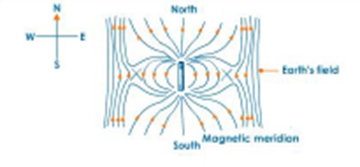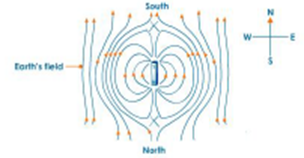Science > Physics > Magnetism > Magnetic Field and Geomagnetism
The branch of physics which deals with the study of earth’s magnetic field is called terrestrial magnetism or geomagnetism. The magnetism on the surface of the earth can be approximately represented by assuming a huge imaginary bar magnet in the interior of the earth. The source of magnetism of the earth is due to the electric current in the magma of the earth at the depth of about 3000 km.
Evidence of Geomagnetism:
The earth is a giant magnet. It is evident from the following examples.
A freely suspended magnetic needle always rests in the north-south direction:
The earth itself is a giant magnet. Its magnetic North pole is near the geographical South pole. Its magnetic South pole is near the geographical North pole. Now, unlike poles of a magnet always attract each other and like poles of the magnet always repel each other. Thus the north pole of the suspended magnet gets attracted towards the magnetic south pole of the earth (geographical north). Similarly, the south pole of the suspended magnet gets attracted towards the magnetic north pole of the earth (geographical south).
Thus the magnet when suspended in the air such that it is free to rotate about a transverse axis passing through its centre, always comes to rest in the north-south direction. Which confirms the existence of magnetic field by the earth.
An iron rod buried inside earth along N-S direction becomes a magnet:
As the magnet is buried inside the earth in the north-south direction, it is acted upon by the earth’s magnetic field. Due to which magnetism is induced in the iron rod and it behaves like a magnet. Which confirms the existence of the magnetic field by the earth.
Existence of neutral point in the magnetic field created by a magnet:
When a magnet is placed in a horizontal plane with its north pole facing geographical north and its south pole facing geographical south and magnetic lines of force created by the magnet are plotted. We obtain two neutral points one on either side of the magnet on its broadside position as shown

When a magnet is placed in a horizontal plane with its north pole facing geographical south and its south pole facing geographical north and magnetic lines of force created by the magnet are plotted. We obtain two neutral points one on either side of the magnet on its end on the position as shown

At these points, the magnetic field is zero. If we keep a magnetic needle at these points, it shows any direction. At these points, the magnetic field created by a magnet is balanced by the horizontal component of the earth’s magnetic field. Thus neutral points are the points where the magnetic field of a magnet is equal in magnitude but opposite in direction to the earth’s magnetic field. The existence of neutral points confirms the existence of the magnetic field by the earth.
A magnetic needle rests with its geometrical axis making different angles at different places on the earth:
If a magnetic needle is suspended in such a way that it is free to rotate in a vertical plane and it is taken around the earth through the earth’s geographical poles and following phenomena are observed:
- We obtain two points on the earth at which the magnetic needle is vertical i.e. it is perpendicular to the earth’s surface. The two places at which the magnetic needle becomes vertical are called magnetic poles. At magnetic poles, the magnetic lines of force by earth are perpendicular to the surface of the earth.
- We obtain two points on the earth at which the magnetic needle is horizontal i.e. it is parallel to the earth’s surface. The line joining these two places is called the magnetic equator. At the magnetic equator, the magnetic lines of force by earth are parallel to the surface of the earth.
- At all other places, the needle comes to rest making different angles with the horizontal. At these places, the magnetic lines of force by earth are inclined to the surface of the earth.
These situations confirm the existence of the magnetic field by the earth.
Earth as a Magnet (Geomagnetism):
The earth itself is a giant magnet. Its magnetic North pole is near the geographical South pole. Its magnetic South pole is near the geographical North pole. The magnetic axis of the earth is inclined at 20° to its geographical axis. North pole of the earth’s magnet is in Antarctica while its south pole is in Northern Canada. The magnetic equator passes through India, near Trivandrum, Kerala.
The magnetic field at the surface of the earth ranges from 3 × 10-5 T at the equator to 6 × 10-5 T at the poles. Note that the magnetic field on the axis is twice at that on the equator. The strength of the magnetic field of the earth is of the order of 1 oersted or 1 gauss (10-4 T).
The strength of the magnetic field on the earth changes from place to place and w.r.t. time. When the change in the strength of the magnetic field is considerable or erratic, it is called the magnetic storm. It is not related to the climactic storm. It is related to the variation of the electric current in the earth’s atmosphere. There is a correlation between magnetic storms and sunspots.
Terminology of Geomagnetism:
- A straight line passing through the geographical poles is called the geographical axis or polar axis of the earth. It is also the axis of rotation of the earth.
- A vertical plane at a place passing trough geographical north and south poles of the earth is called the geographic meridian at that place.
- The great circle on the surface of the earth, in a plane perpendicular to the geographical axis, is called the geographic equator. All the points on the geographic equator are at equal distances from the geographical poles.
- A straight line passing through the magnetic poles is called the magnetic axis of the earth.
- A vertical plane at a place passing through magnetic north and south poles of the earth is called the magnetic meridian at that place.
- The great circle on the surface of the earth, in a plane perpendicular to the magnetic axis, is called the magnetic equator. All the points on the magnetic equator are at equal distances from the magnetic poles.
- The angle between the magnetic meridian and the geographic meridian at a place is called the declination or variation at that place. There is a periodic variation in the value of declination at a place.

At a given place the Earth’s magnetic field can be resolved into horizontal and vertical components. The angle made by the Earth’s magnetic field with its horizontal component is called the angle of dip or angle of inclination. The value of the angle of dip changes from place to place. It depends on the strength of the magnetic field of the earth at that place. Its value is zero at the magnetic equator and 90° at Earth’s magnetic poles. The angle of dip at a place is measured by a device called dip circle.

As the magnetic needle is moved towards the north pole or south pole, the angle of dip increases. In the northern hemisphere, the north pole of the magnetic needle dips whereas in the southern hemisphere the north pole of the magnetic needle dips
The lines drawn up on the map through places having the same declination are called isogonic lines.

The line drawn through places that have zero declination is known as an agonic line.

The line joining all the places on the earth having the same angle of dip or inclination is called the isoclinic line.

The line drawn through places that have zero angles of dip or inclination is known as the clinic line and it is the magnetic equator.

The earth’s magnetic field creates a spectacular, visual effect called ‘aurora borealis’ in the north and ‘aurora australis’ in the south. The solar winds consisting of the stream of electrons and protons are trapped at magnetic poles, above the atmosphere. When moving down these winds ionises molecules of the atmosphere, giving rise to the aurora effect.
Previous Topic: Magnetic Field and Magnetic Lines of Force
Next Topic: Types of Magnetic Materials